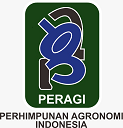EFEK DEFOLIASI TERHADAP LAJU PERIMBANGAN TANAMAN UBI JALAR
Abstract
Keywords
Full Text:
PDFReferences
Fuller, M. F. (2004). The Encyclopedia of farm animal nutrition. CABI publishing.
Gibberson, D. (2011). The Effect of Defoliation on the Quality of Sweet Potato Tubers. Asian J. Agric. Res. 5:300–305.
Gong, Y., J. Zhang, X. Guo, X. Wan, Z. Liang, H. CJ, M. & Jiang. (2013). Identification and characterization of PtDGAT2B, an acyltransferase of the DGAT2 acyl-coenzyme A: diacylglycerol acyltransferase family in the diatom Phaeodactylum tricornutum. FEBS Lett. 587:481–487.
Indawan, E., S.U. Lestari, & N. Thiasari. (2018). Sweet potato response to biochar application on sub-optimal dry land. J. Degrad. Min. Lands Manag. 5:1133–1139.
Indawan, E., S.U. Lestari, N. Thiasari, & P. Sasongko. (2020). The Pruning Effect on the Storage Root Yield and Starch Content of Sweet Potato Clones Planted at Dry Land. Caraka Tani J. Sustain. Agric. 35:289–298.
Liu, Z., Y. Zhu., F. Li., & G. Jin. (2017). Non-destructively predicting leaf area, leaf mass and specific leaf area based on a linear mixed-effect model for broadleaf species. Ecol. Indic. 78:340–350.
Novianti, D., & A. Setiawan. (2018). Pengaruh Pemangkasan Pucuk dan Jarak Tanam terhadap Pertumbuhan dan Produksi Bibit Ubi Jalar (Ipomoea batatas L.). Bul. Agrohorti 6:143.
Rahmiana, E.A., S.Y. tiasmoro., & N.E. Suminarti. (2015). Pembalikan Batang pada Pertumbuhan dan Hasil Tanaman Ubi Jalar (Ipomoea batatas L) Varietas Madu Oranye. J. Produksi Tanam. 3 (2): 126–134.
Sadras, V.O., F.J. Villalobos, & E. Fereres. (2016). Crop development and growth. Principles of Agronomy for Sustainable Agriculture. Springer, Cham, pp. 141–158.
Sitompul, S. M. (2015). Analisa Pertumbuhan Tanaman. Penerbit UB Press. Malang.
Suminarti, N.E., & R. Novriani. (2017). Pengaruh Defoliasi dan Posisi Penanaman Stek Batang pada Pertumbuhan dan Hasil Tanaman Ubi Jalar (Ipomoea batatas L.) Lam. Var. Sari. J. Biodjati 2 (1): 21-29.
Wahyuni, T.S., & J. Wargiono. (2012). Morfologi dan Anatomi Tanaman. Prosiding. Puslitbangtan. Balitbangtan, Balitkabi, Malang.37–56.
Wawo, A.H., P. Lestari, & N. Setyowati. (2019). Respon Pertumbuhan dan Produksi Empat Kultivar Ubi Jalar (Ipomea batatas L . Poir ) Dataran Tinggi Papua Terhadap Pemangkasan Pucuk. J. Biota. 4 (3): 94–103.
Widaryanto, E., & A. Saitama. (2017). Analysis of plant growth of ten varieties of sweet potato (ipomoea batatas L.) cultivated in rainy season. Asian J. Plant Sci. 16:193–199.
Winardi, R.R., & F.R. Sitepu. (2017). Respon Campuran Media Tanam dan Perlakuan Fisik Terhadap Laju Pertumbuhan dan Produksi Pada Tanaman Ubi Jalar (Ipomea batatas L). J. Agroteknosains 1 (1):46–59.
Zhang, Y.C., J.D. Wang, Y.X. Shi, & D.F. Ma. (2017). Nutrient Management for High Efficiency Sweet Potato Production. Phytonutritional Improvement of Crops. 471–497.
Refbacks
- There are currently no refbacks.


























